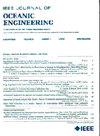Monitoring the Venice Lagoon: An IoT Cloud-Based Sensor Network Approach
IF 3.8
2区 工程技术
Q1 ENGINEERING, CIVIL
引用次数: 0
Abstract
The impact of global warming is felt worldwide, but coastal regions are particularly vulnerable, and face rising sea levels, increased seaquakes, and floods. In addition, the ecosystems of rivers, seas and lakes undergo significant changes due to climate change and pollutants. Thus, monitoring coastal areas, such as the Venice Lagoon (Italy), is of significant importance. This article presents a novel floating wireless sensor system for measuring water-related parameters. The core of the system is the SENSWICH platform, which integrates sensors to measure pH, electrical conductivity, turbidity, dissolved oxygen, and water level. The platform uses long range wide area network (LoRaWAN) connectivity for long-range data collection, which is then aggregated in the Amazon Web Service cloud and visualized using Grafana. While the proposed architecture can be applied to any large-scale coastal, lakeside or riverine monitoring context, it is specifically designed for the Venice Lagoon. This article presents results from two SENSWICH platforms: one in the Piovego river, Padova, which is a tributary of the Venice Lagoon, and one in Chioggia, in the lagoon itself. Together with these results, an analysis for a full-scale deployment in the whole Venice Lagoon is proposed. The results show that SENSWICH, despite being a low-cost platform compared to similar technologies available on the market, enables pervasive monitoring of large water surfaces. It provides reliable datasets over prolonged periods and significantly reduces human resource requirements. The proposed software framework for data aggregation is effective for managing large quantities of data acquired using a LoRaWAN network and is user-friendly through the graphic tool.威尼斯泻湖监测:基于云的物联网传感器网络方法
全球变暖的影响遍及世界各地,但沿海地区尤其脆弱,面临着海平面上升、海震加剧和洪水泛滥等问题。此外,由于气候变化和污染物的影响,河流、海洋和湖泊的生态系统也发生了重大变化。因此,对威尼斯泻湖(意大利)等沿海地区进行监测具有重要意义。本文介绍了一种用于测量水相关参数的新型浮动无线传感器系统。该系统的核心是 SENSWICH 平台,它集成了用于测量 pH 值、电导率、浊度、溶解氧和水位的传感器。该平台使用长距离广域网(LoRaWAN)连接进行远距离数据收集,然后将数据汇总到亚马逊网络服务云中,并使用 Grafana 进行可视化。虽然所提议的架构可应用于任何大规模的沿海、湖边或河流监测环境,但它是专门为威尼斯泻湖设计的。本文介绍了两个 SENSWICH 平台的结果:一个位于威尼斯泻湖的支流帕多瓦 Piovego 河,另一个位于泻湖本身的基奥吉亚。根据这些结果,我们提出了在整个威尼斯泻湖进行全面部署的分析方案。结果表明,尽管与市场上的同类技术相比,SENSWICH 是一种低成本平台,但它能够对大型水面进行普遍监测。它能长期提供可靠的数据集,并大大减少对人力资源的需求。拟议的数据汇总软件框架可有效管理利用 LoRaWAN 网络获取的大量数据,而且通过图形工具方便用户使用。
本文章由计算机程序翻译,如有差异,请以英文原文为准。
求助全文
约1分钟内获得全文
求助全文
来源期刊

IEEE Journal of Oceanic Engineering
工程技术-工程:大洋
CiteScore
9.60
自引率
12.20%
发文量
86
审稿时长
12 months
期刊介绍:
The IEEE Journal of Oceanic Engineering (ISSN 0364-9059) is the online-only quarterly publication of the IEEE Oceanic Engineering Society (IEEE OES). The scope of the Journal is the field of interest of the IEEE OES, which encompasses all aspects of science, engineering, and technology that address research, development, and operations pertaining to all bodies of water. This includes the creation of new capabilities and technologies from concept design through prototypes, testing, and operational systems to sense, explore, understand, develop, use, and responsibly manage natural resources.
 求助内容:
求助内容: 应助结果提醒方式:
应助结果提醒方式:


